|

Meinem Lehrer und Freund
Prof. Dr. Heinrich von
Stietencron
ist die gesamte
Amarakośa-Übersetzung
in Dankbarkeit gewidmet. |
|
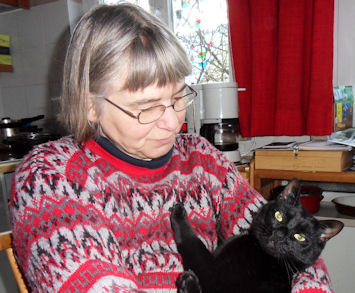
Meiner lieben Frau
Margarete Payer
die all meine Interessen teilt und fördert
ist das Tierkapitel in
Dankbarkeit besonders gewidmet |
Falls Sie die diakritischen Zeichen nicht dargestellt bekommen, installieren Sie
eine Schrift mit Diakritika wie z.B. Tahoma.
Die Devanāgarī-Zeichen sind in Unicode kodiert. Sie benötigen also eine
Unicode-Devanāgarī-Schrift.
|
"Those who have never considered the subject are
little aware how much the appearance and habit of a plant become
altered by the influence of its position. It requires much
observation to speak authoritatively on the distinction in point of
stature between many trees and shrubs. Shrubs in the low country,
small and stunted in growth, become handsome and goodly trees on
higher lands, and to an inexperienced eye they appear to be
different plants. The Jatropha curcas grows to a tree some 15
or 20 feet on the Neilgherries, while the Datura alba is
three or four times the size in>n the hills that it is on the
plains. It is therefore with much diffidence that I have
occasionally presumed to insert the height of a tree or shrub. The
same remark may be applied to flowers and the flowering seasons,
especially the latter. I have seen the Lagerstroemia Reginae,
whose proper time of flowering is March and April, previous to the
commencement of the rains, in blossom more or less all the year in
gardens in Travancore. I have endeavoured to give the real or
natural flowering seasons, in contradistinction to the chance ones,
but, I am afraid, with little success; and it should be recollected
that to aim at precision in such a part of the description of plants
is almost hopeless, without that prolonged study of their local
habits for which a lifetime would scarcely suffice."
[Quelle: Drury, Heber <1819 - 1872>:
The useful plants of India : with notices of their chief value in
commerce, medicine, and the arts. -- 2d ed. with additions and
corrections. London : Allen, 1873. -- xvi, 512 p. ; 22 cm. -- S.
VIII f.] |
2. dvitīyaṃ kāṇḍam - Zweiter Teil
2.9. siṃhādivargaḥ - Abschnitt über Löwen und andere
Tiere
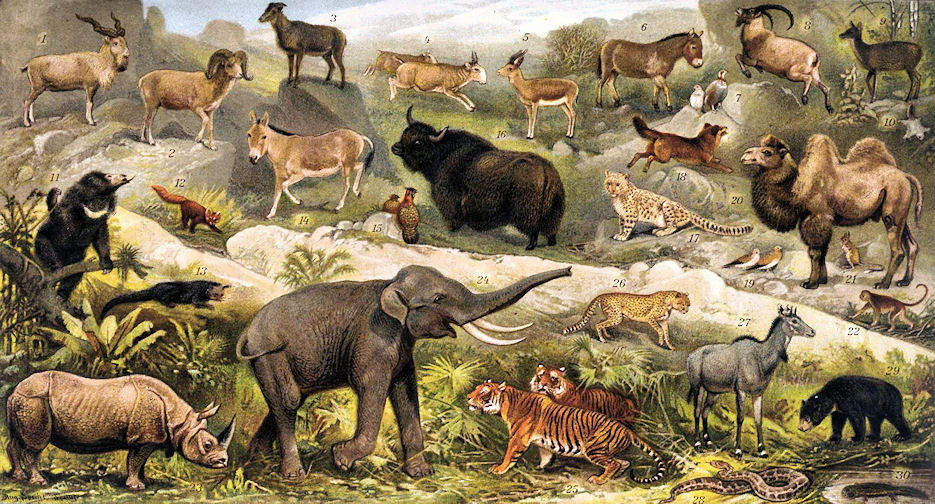
Abb.: Asiatische Tierwelt
[Bildquelle: Brockhaus' Kleines Konversationslexikon, 1906]
Referenzwerke:
Mammal species of the world
: a taxonomic and geographic reference / ed. by Don E. Wilson and DeeAnn M.
Reeder. -- 3. ed. -- Baltimore : John Hopkins Univ. Pr., 2005. -- 2 Bde. :
2142 S. -- ISBN 0-8o18-8221-4 [Normierend für lateinische und englische
Säugetiernamen]
Menon, Vivek:
Mammals of India. -- New Jersey : Princeton UP, ©2009. -- 201 S. : Ill. --
ISBN 978-0-691-14067-4 [Sehr gute Übersicht über die wichtigsten Säugetiere
Indiens]
Walker's mammals of the world
/ Ronald M. Nowak; John L. Paradiso. - Baltimore, Md. [u.a.] : Johns Hopkins
Univ. Pr., 1999. -- 2 Bde. -- ISBN 0-8018-3970-X [Referenzwerk für
Säugetiere]
Übersicht
2.9.64. Microchiroptera - Fledermäuse - Bats
|
26. a./b. jatukājinapatrā syāt paroṣṇī tailapāyikā
जतुकाजिनपत्रा स्यात् परोष्णी तैलपायिका ।२६ क।
[Bezeichnungen für Fledermäuse:]
-
जतुका - jatukā f.:
Jatukā (vielleicht zu jatu n.: Lack, Gummi)
- अजिनपत्रा
- ajinapatrā f.: Fell-Flüglerin, pelzige Geflügelte
|
Colebrooke (1807): "A bat."
In Indien gibt es über 110 Arten von Fledermäusen. Hier folgt je ein Beispiel
aus den in Indien vertretenen Familien.
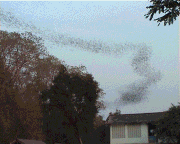
Abb.: जतुकाः । Fledermäuse schwärmen aus einer Höhle in Thailand
[Bildquelle: Max Maus / Wikipedia. -- GNU FDLicense]
Abbildungen nicht identifizierter Fledermäuse
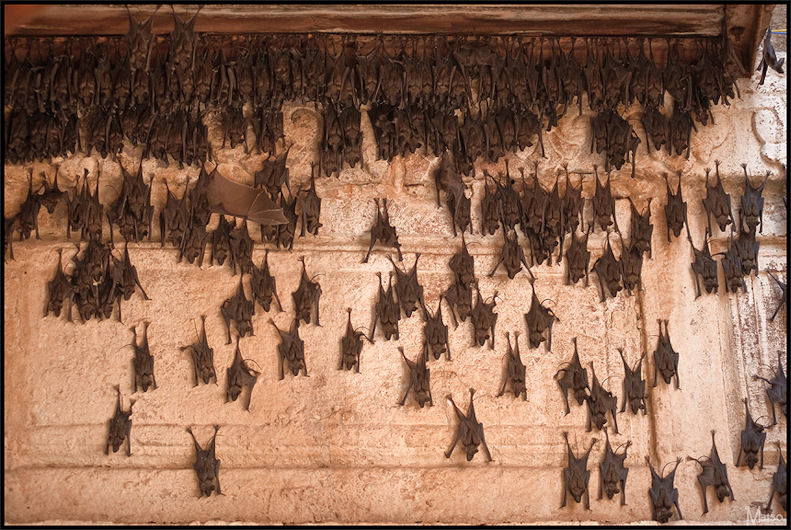
Abb.: जतुकाः । Fledermäuse, Jodhpur - जोधाणा,
Rajasthan
[Bildquelle: Matso. --
http://www.flickr.com/photos/matso/4117342943/. -- Zugriff am 2010-12-22. --
Creative Commons Lizenz (Namensnennung, keine kommerzielle Nutzung, keine
Bearbeitung)]
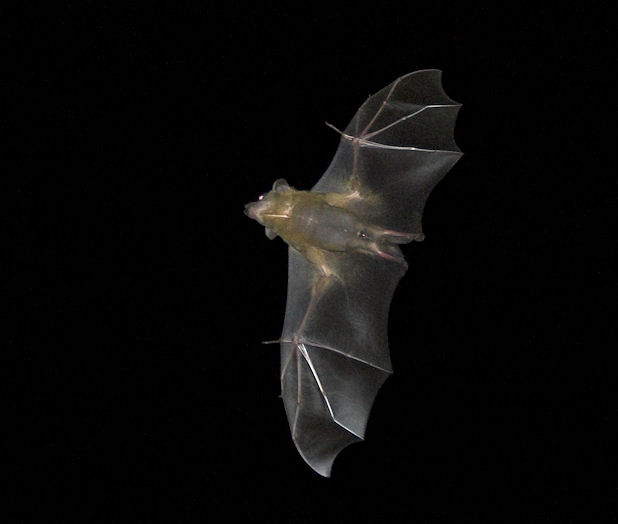
Abb.: जतुका । Fledermaus; Ahmednagar - अहमदनगर, Maharashtra
[Bildquelle:
Harshad Sharma. --
http://www.flickr.com/photos/harshadsharma/201177284/. -- Zugriff am
2010-12-22. --
Creative
Commons Lizenz (Namensnennung, keine kommerzielle Nutzung, keine
Bearbeitung)]
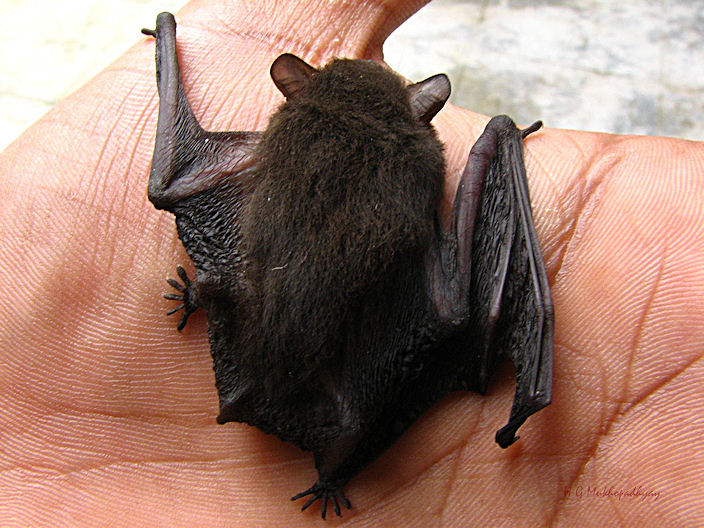
Abb.: अजिनपत्रा
। Fledermaus, Kolkata - কলকাতা,
West Bengal
[Bildquelle:
H G Mukhopadhyay. --
http://www.flickr.com/photos/hgmphotos/3747165363/. -- Zugriff am
2010-12-22. --
Creative
Commons Lizenz (Namensnennung, keine kommerzielel Nutzung, keine
Bearbeitung)]
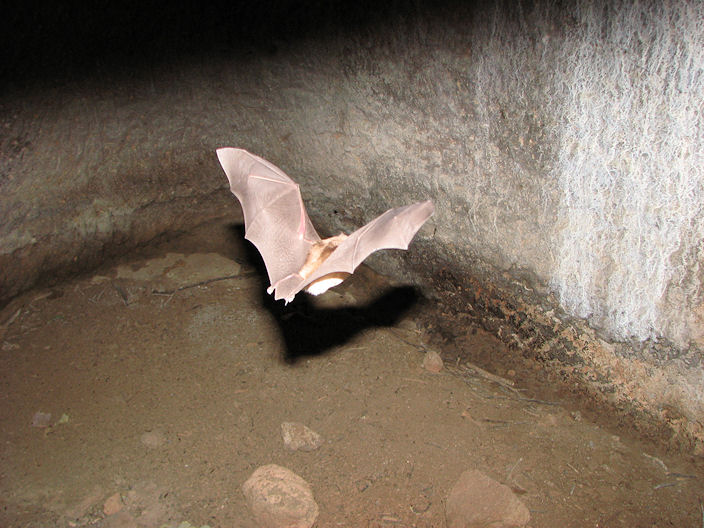
Abb.: जतुका । Fledermaus, Bandhavgarh National Park - बांधवगढ राष्ट्रीय उद्दान, Madhya
Pradesh
[Bildquelle:
Indraneel Biswas. --
http://www.flickr.com/photos/colouredglass/2157027385/. -- Zugriff am
2010-12-22. -- Creative Commons Lizenz (Namensnennung, keine kommerzielel
Nutzung, keine Bearbeitung)]
Maegaderma lyra E. Geoffroy, 1810 - Greater False Vampire
- Großer Falscher Vampir
|
"Megaderma lyra.
THE LARGE-EARED VAMPIRE BAT.
[...]
This curious-looking bat is found over all
India, from the foot of the Himalayas to the extreme South, frequenting
old buildings, pagodas, caves, roofs of houses, &c. It is very
abundant in the innermost compartments of the cave temples of Ellora and Ajanta.
Hodgson considered those he procured (which were under the roof
of the Dak bungalow at Silligoree, at the foot of the Sikim
Himalayas) distinct ; but I got specimens from the very same locality and
found them apparently quite identical with those from Southern India.
Horsfield, indeed, when noticing Hodgson's new Mammals, &c., stated
that dry specimens could not be distinguished from M. lyra.
Mr. Blyth has fully ascertained that this bat
at times sucks the blood from other bats, fixing on them behind the
ear, sucking the blood during flight, and then devouring the body. It has
also been known to eat frogs and fish. Hodgson found insects only in those he examined."
[Quelle: Jerdon,
Thomas Claverhill <1811-1872>: The mammals of India : a natural history of
all the animals known to inhabit continental India. -- London, 1874. -- S.
22] |
Pteropodidae - Fruit Bats - Flughunde
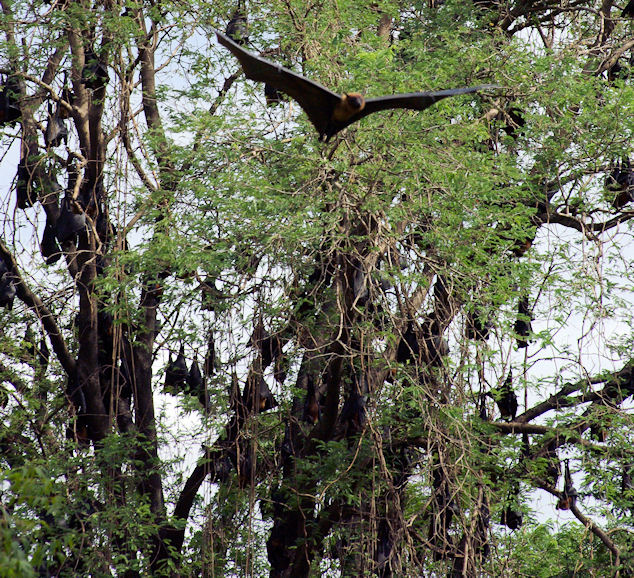
Abb.: अजिनपत्राः
। Flughunde, Thanjavur - தஞ்சாவூர்,
Tamil Nadu
[Bildquelle: داود. --
http://www.flickr.com/photos/david-trattnig/2791580385/. -- Zugriff am
2010-12-22. --
Creative
Commons Lizenz (Namensnennung, keine kommerzielel Nutzung, share alike)]
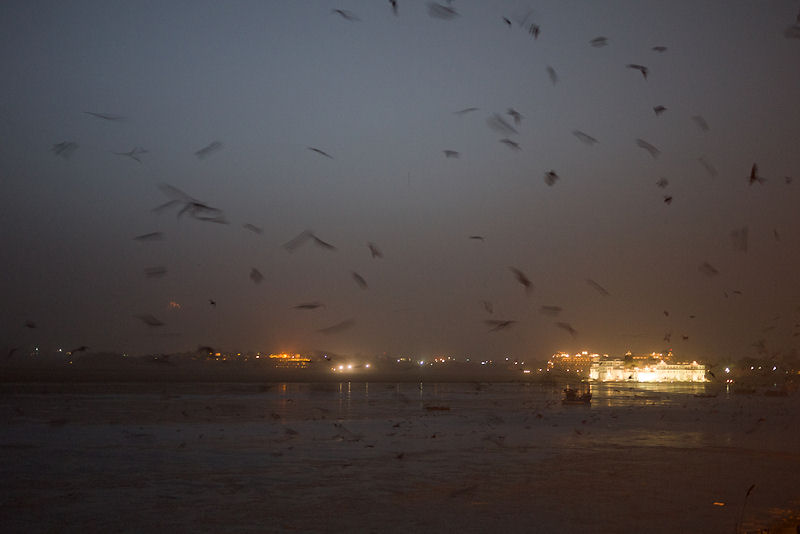
Abb.: अजिनपत्राः
Flughunde über Udaipur - उदयपुर, Rajasthan
[Bildquelle: Raam Dev. --
http://www.flickr.com/photos/raamdev/4667569937/. -- Zugriff am 2010-12-22.
-- Creative
Commons Lizenz (Namensnennung, keine kommerzielle Nutzung, share alike)]
Pteropus giganteus Brünnich, 1782 - Indian Flying Fox - Indischer
Riesenflughund
Körperlänge: 20 - 30 cm
Lebensraum: ganz Indien, besonders auf Alleebäumen, in der Nähe von Ackerland
und menschlichen Behausungen
Lebt in großen Kolonien
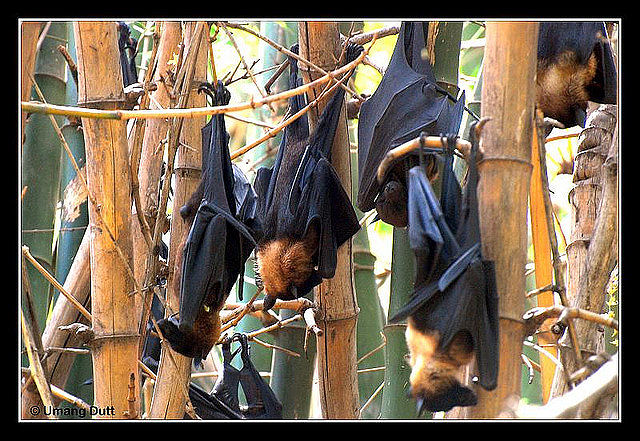
Abb.: जतुकाः । Pteropus giganteus Brünnich, 1782 - Indian Flying Fox - Indischer
Riesenflughund, Ahmedabad - અમદાવાદ,
Gujarat
[Bildquelle:
Umang Dutt. --
http://www.flickr.com/photos/snapflickr/2456084948/. -- Zugriff am
2010-12-22. --
Creative
Commons Lizenz (Namensnennung, keine kommerzielle Nutzung, keine
Bearbeitung)]
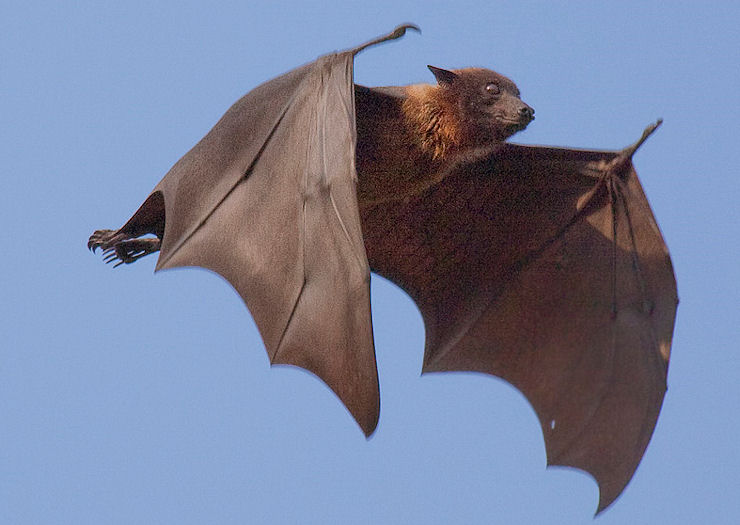
Abb.: अजिनपत्रा
। Pteropus giganteus Brünnich, 1782 - Indian Flying Fox - Indischer
Riesenflughund, Nagpur - नागपूर,
Maharashtra
[Bildquelle:
Tarique Sani. --
http://www.flickr.com/photos/tariquesani/4449374539/. -- Zugriff am
2010-12-22. --
Creative
Commons Lizenz (Namensnennung, keine kommerzielel Nutzung, share alike)]
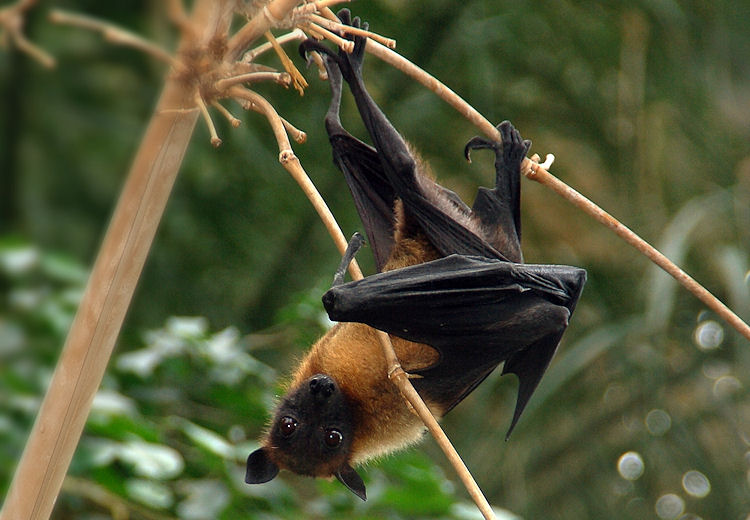
Abb.: अजिनपत्रा
। Pteropus giganteus Brünnich, 1782 - Indian Flying Fox - Indischer
Riesenflughund, Zoo
[Bildquelle: Fritz Geller-Grimm / Wikimedia. --
Creative Commons
Lizenz (Namensnennung, share alike)]
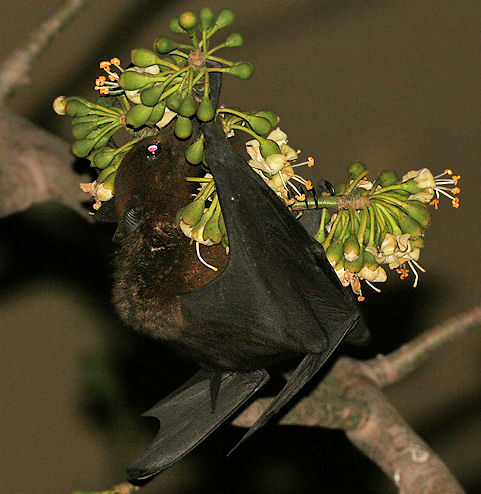
Abb.: अजिनपत्रा
। Pteropus giganteus Brünnich, 1782 - Indian Flying Fox - Indischer
Riesenflughund auf Ceiba pentandra, Kolkata -
কলকাতা, West Bengal
[Bildquelle: J. M. Garg / Wikimedia. -- GNU FDLicense]
|
"This large bat, the flying fox of Europeans,
is found throughout all India, Ceylon, and Burmah. Specimens vary
considerably in shade and colouration.
During the day they roost on trees, generally
in large colonies, many hundreds often occupying a single tree, to
which they invariably resort if not driven away. Towards sunset they begin to
get restless, move about along the branches, and by ones and twos fly
off for their nightly rounds. If water is at hand, a tank, or a river, or
the sea, they fly cautiously down and touch the water, but I could not
ascertain if they took a sip, or merely dipped part of their bodies in. They fly
vast distances occasionally to such trees as happen to be in fruit. They are
fond of most garden fruit (except oranges, &c.), also the neem,
jamoon, bēr, and various figs. About the early dawn they return from their
hunting-grounds, and the scene that then daily takes place is well
described by Tickell, in an excellent memoir published in the Calcutta Journal of
Natural History, from which I extract the following :
"From the arrival of the first comer until
the sun is high above the horizon, a scene of incessant wrangling and
contention is enacted among them, as each endeavours to secure a higher
and better place, or to eject a neighbour from too close vicinage. In
these struggles the bats hook themselves along the branches, scrambling
about hand over hand with some speed, biting each other severely,
striking out with the long claw of the thumb, shrieking and cackling without
intermission. Each new arrival is compelled to fly several times round the
tree, being threatened from all points, and when he eventually hooks
on he has to go through a series of combats, and be probably ejected
two or three times before he makes good his tenure."
The female brings forth only one young one,
which adheres firmly to the breast, retaining its position whether
the dam be flying or at rest.
The flesh is esteemed good eating by some.
Colonel Syke calls it delicate, and with no bad flavour, and states that it
is eaten by the native Portuguese. Many classes in the Madras presidency also
eat it.
Whilst on service with my regiment in the
Ghazeepore district during the mutiny in 1858, the force was encamped in
a grove of trees, on one of which was a rather small colony of
these Pteropi. The wind which had hitherto been from the east and moist,
suddenly changed to a fierce, hot, dry, westerly blast, and this so
affected the bats, that one by one they descended to lower branches, being blown to
leeward of course at the same time, and eventually fell to the ground,
and many were picked up, panting and all but lifeless, others
quite dead, by our followers, Madras grooms, and grass-cutters. Several
birds and numerous flies also perished from the same cause."
[Quelle: Jerdon,
Thomas Claverhill <1811-1872>: The mammals of India : a natural history of
all the animals known to inhabit continental India. -- London, 1874. -- S. 18ff.]
|













